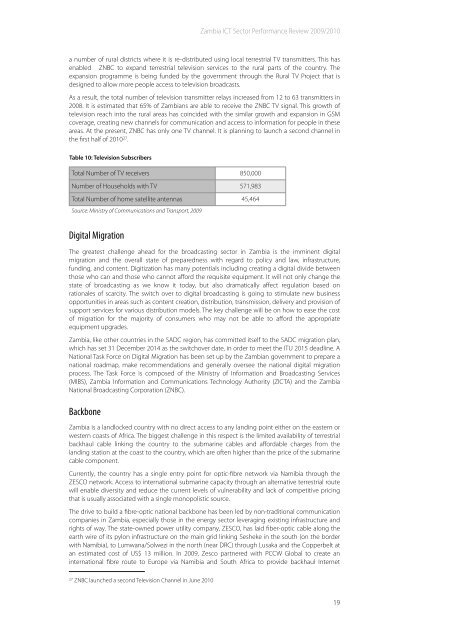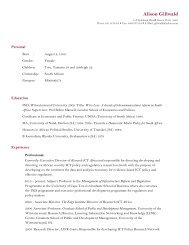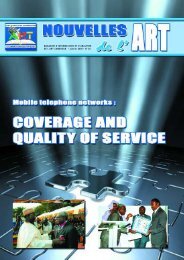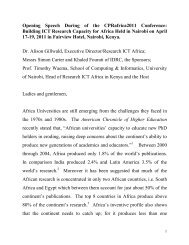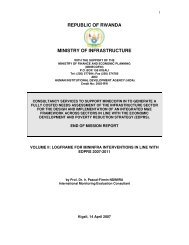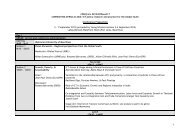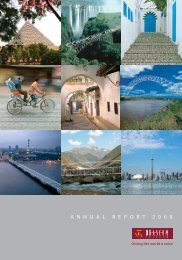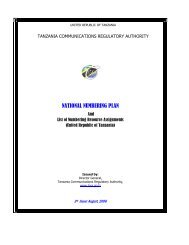Zambia ICT Sector Performance Review 2010 - Research ICT Africa
Zambia ICT Sector Performance Review 2010 - Research ICT Africa
Zambia ICT Sector Performance Review 2010 - Research ICT Africa
Create successful ePaper yourself
Turn your PDF publications into a flip-book with our unique Google optimized e-Paper software.
<strong>Zambia</strong> <strong>ICT</strong> <strong>Sector</strong> <strong>Performance</strong> <strong>Review</strong> 2009/<strong>2010</strong><br />
a number of rural districts where it is re-distributed using local terrestrial TV transmitters. This has<br />
enabled ZNBC to expand terrestrial television services to the rural parts of the country. The<br />
expansion programme is being funded by the government through the Rural TV Project that is<br />
designed to allow more people access to television broadcasts.<br />
As a result, the total number of television transmitter relays increased from 12 to 63 transmitters in<br />
2008. It is estimated that 65% of <strong>Zambia</strong>ns are able to receive the ZNBC TV signal. This growth of<br />
television reach into the rural areas has coincided with the similar growth and expansion in GSM<br />
coverage, creating new channels for communication and access to information for people in these<br />
areas. At the present, ZNBC has only one TV channel. It is planning to launch a second channel in<br />
the first half of <strong>2010</strong> 27 .<br />
Table 10: Television Subscribers<br />
Total Number of TV receivers 850,000<br />
Number of Households with TV 571,983<br />
Total Number of home satellite antennas 45,464<br />
Source: Ministry of Communications and Transport, 2009<br />
Digital Migration<br />
The greatest challenge ahead for the broadcasting sector in <strong>Zambia</strong> is the imminent digital<br />
migration and the overall state of preparedness with regard to policy and law, infrastructure,<br />
funding, and content. Digitization has many potentials including creating a digital divide between<br />
those who can and those who cannot afford the requisite equipment. It will not only change the<br />
state of broadcasting as we know it today, but also dramatically affect regulation based on<br />
rationales of scarcity. The switch over to digital broadcasting is going to stimulate new business<br />
opportunities in areas such as content creation, distribution, transmission, delivery and provision of<br />
support services for various distribution models. The key challenge will be on how to ease the cost<br />
of migration for the majority of consumers who may not be able to afford the appropriate<br />
equipment upgrades.<br />
<strong>Zambia</strong>, like other countries in the SADC region, has committed itself to the SADC migration plan,<br />
which has set 31 December 2014 as the switchover date, in order to meet the ITU 2015 deadline. A<br />
National Task Force on Digital Migration has been set up by the <strong>Zambia</strong>n government to prepare a<br />
national roadmap, make recommendations and generally oversee the national digital migration<br />
process. The Task Force is composed of the Ministry of Information and Broadcasting Services<br />
(MIBS), <strong>Zambia</strong> Information and Communications Technology Authority (Z<strong>ICT</strong>A) and the <strong>Zambia</strong><br />
National Broadcasting Corporation (ZNBC).<br />
Backbone<br />
<strong>Zambia</strong> is a landlocked country with no direct access to any landing point either on the eastern or<br />
western coasts of <strong>Africa</strong>. The biggest challenge in this respect is the limited availability of terrestrial<br />
backhaul cable linking the country to the submarine cables and affordable charges from the<br />
landing station at the coast to the country, which are often higher than the price of the submarine<br />
cable component.<br />
Currently, the country has a single entry point for optic-fibre network via Namibia through the<br />
ZESCO network. Access to international submarine capacity through an alternative terrestrial route<br />
will enable diversity and reduce the current levels of vulnerability and lack of competitive pricing<br />
that is usually associated with a single monopolistic source.<br />
The drive to build a fibre-optic national backbone has been led by non-traditional communication<br />
companies in <strong>Zambia</strong>, especially those in the energy sector leveraging existing infrastructure and<br />
rights of way. The state-owned power utility company, ZESCO, has laid fiber-optic cable along the<br />
earth wire of its pylon infrastructure on the main grid linking Sesheke in the south (on the border<br />
with Namibia), to Lumwana/Solwezi in the north (near DRC) through Lusaka and the Copperbelt at<br />
an estimated cost of US$ 13 million. In 2009, Zesco partnered with PCCW Global to create an<br />
international fibre route to Europe via Namibia and South <strong>Africa</strong> to provide backhaul Internet<br />
27 ZNBC launched a second Television Channel in June <strong>2010</strong><br />
19


